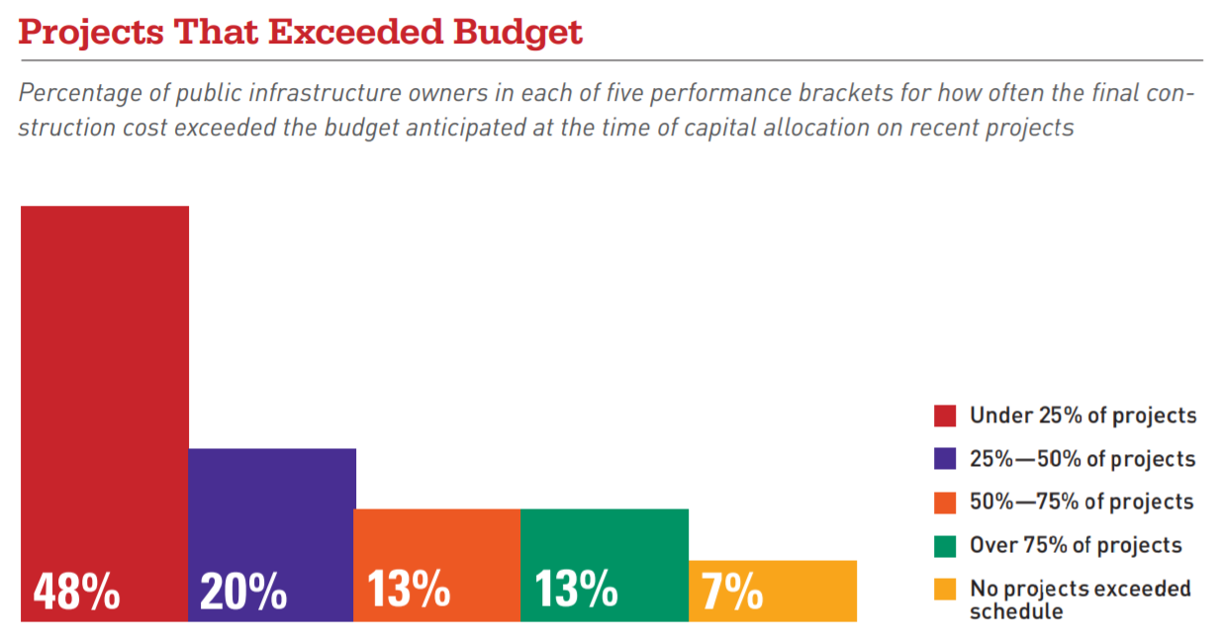Construction Project Management
15 Helpful Signs to Enhance Your Capital Improvement Program Software
by Chris Bell | October 1, 2020
Thousands of facility and asset owners shared their struggles about managing CIPs. Learn what to look for to ensure a healthy capital improvement program year over year.
What is a Capital Improvement Program (CIP)?
A capital improvement program (CIP) is a fiscal and organizational planning process used to coordinate the scope, timing, and financing of prioritized projects for an organization, community, or government agency. Great CIPs describe a vision and a plan over a multi-year period for non-recurring expenditures such as land, buildings, infrastructure, and equipment. Often, projects that make up a capital improvement program are ranked by priority and a year-by-year schedule with estimated costs.
CIPs are considered a “living document” and must be updated on a regular basis. It’s referred to as “living” because it can change and adapt. As such, someone needs to watch over it to help ensure its ongoing health. CIPs will often signal to its owner when it is thriving and when it is unhealthy. And yes, sometimes the symptoms of illness that occur are very subtle and can be overlooked. If these symptoms are not caught early enough, problems can have a long-lasting negative impact.
Owners Share Their Thoughts on Capital Improvement Projects
We have had the opportunity to speak with thousands of facility and asset owners who lead capital improvement programs for their organizations. Owners from government agencies, educational institutions, healthcare organizations and private-sector companies with CIP budgets less than $10 million to over $ 3 billion annually. These owners have openly shared with us the symptoms of an unhealthy CIP. We are sharing them with you in hopes that you can spot them early to prevent irrecoverable impacts in your organization.
Calendar year 2020 surely taught us that conditions change virtually overnight. Economic swings dramatically change the landscape of financing. Public priorities shift in a blink of an eye. Great CIPs can adapt, and pivot as needed. However, you must always be vigilant and watchful for subtle signs of capital improvement program health.
What Signs to Look for in Capital Improvement Programs:
1) Project Schedule Delays
According to a landmark study performed by Dodge Data & Analytics in conjunction with Construction Owners Association of America (COAA) and Lean Construction Institute (LCI), owners reported that 92% of their projects in their capital improvement program exceeded the original baseline schedule. The interesting takeaway was that 41% that experienced delay saw this happen in 25% or more of their projects.
Habitual schedule delay is an obvious sign of a poorly performing CIP. Anecdotally, most owners have a seemingly valid excuse as to why a capital improvement project was delayed. Unforeseen conditions, permit delays, a poor performing contractor. Regardless of what today’s rationale is for delay, smart owners are looking at the trend. Is there an increasing number of projects that are delayed? If so, take it as a sign to invest in construction management software with project scheduling capabilities.
2) Project Cost Overrun
In the same study, 85% of owners surveyed reported they have projects that exceeded the original baseline budget. Similarly, 33% of owners experiencing cost overrun saw this happen in 25% or more of their projects. Perhaps your capital improvement program is dynamic and forgiving enough to withstand 10% cost overrun due to your well-funded contingency budget. If so, this may not be a sign for your organization to invest in construction cost management software.
Source: Optimizing the Owner Organization Smart Market Brief, Dodge Data & Analytics
However, countless owners, particularly in government and non-profit shared that they have no contingency at all. The impact of cost overrun on one project means funding for another project is sequestered and your organization gets one less project towards its vision and goals. That is a very steep trade-off and unfortunately, it happens all too often.
3) Damaged Reputation Due to Project Failure
While a damaged reputation due to project failure for a capital improvement plan team is bad, it can be a career-limiting move for the top program official such as a Chief Engineer or Vice President of Capital Projects. Many have depicted a common dreaded scenario: Waking up one day to see a picture of their jobsite on the local news and read “Project in Trouble” headline.
If this hasn’t happened to you personally, you probably know someone that it has. A common theme they share was that the project had been in trouble since the very beginning, and they felt helpless in trying to fix it. They regret that if they could do it all over again, they would have put more controls in place early and made their process crystal clear.
4) Lack of Trust in the Project Data
Trust is everything in construction. When you get a cost and schedule Project Management Baseline (PMB) for the project and progress updates take weeks or months to obtain, something is wrong. Signals of this problem are a myriad of Excel spreadsheets with sophisticated naming conventions such as “project_budget_committments_April_v2.2.3_ckb_edits.xlsx”.
Problems that carry cost and schedule impact on a project arise and are resolved in days or weeks and if you can’t see that in your performance reports because it is so labor-intensive that you have to wait 60 days to get it, you will miss your opportunity to make intentional decisions that keep projects within the boundaries of scope, schedule and budget. Our experience is that over 50% of owners don’t trust their data. The question is, how can you make data-driven decisions if that is the case?
5) High Rate of Change Orders
Want to know the single largest source of change orders? Owner-directed changes. Did you think we were going to say unforeseen conditions or design omissions? Wrong. We know, it’s hard to hear but owners are often the source of late changes on projects because the owner didn’t do a great job with internal stakeholder communication on the scope.
The good news is that this is clearly within the control of the owner of the CIP. Changes will happen. But fast, efficient, and early communication about a change is key to keeping the project rolling and giving your end-users what they are looking for. If you have a high rate of change orders (exceeding 2% of your project budget), this is a problem and you should look to address it with improved collaboration and change control.
6) Late or Lengthy Contractor Payments (> 30 Days)
Slow or late contractor payments are a sign of high process friction. Friction in payments looks like e-mail escalations, phone call follow-ups from vendors, excuses from finance, and in many cases, walking payment applications to each person who needs to sign off and dropping it off at the FedEx box.
Late contractor payments have multiple impacts. First and most important, they cause your vendors to become administrators and accounts receivables professionals instead of the amazing contractors you hired them to be. They lose focus on the scope of work which isn’t good for you or them. The lasting impact is that your organization builds a reputation in the marketplace for being a slow payer or difficult owner. This will cause your next bids to include additional costs to compensate for your inefficiency. In the end, slow pay customers pay 10% more for their projects and don’t attract the “A” players exposing you to more risk.
7) Being Late in Identifying or Learning About Problems and Issues
Slow issue identification and communication is a classic, subtle sign that is very easy to miss. The concrete trucks that didn’t show up to pour the foundation on time, that is easy to spot. The hard one to spot is the mounting number of RFIs on a steel detail in your one-of-a-kind lobby, that’s the one that is likely to bite you not today but later in a claim.
Monitoring how quickly your CIP team can spot an issue and resolve it takes close monitoring of the communication that happens on your project. You can’t read and track every email. Best-in-class owners rely upon construction management software to help them put project correspondence, meeting minutes, action items and issues into a database that they can report on to stay on top of their capital improvement program.
8) Contractor Claims and Litigation
Construction has earned a reputation for being one of the most litigious industries in the world. It’s no surprise as to why. We have lots of organizations, many of which have not worked together before coming together to deliver a one-of-a-kind project with millions of dollars at stake.
Owners share one simple truth. He who has the most documentation wins. Perhaps you have countless file rooms with mountains of papers. Great, you win – or do you? If you can’t quickly and efficiently retrieve the evidence you need to protect yourself from claims, what good is all that storage? Early warning signs your CIP is about to experience claim exposure is an increase of information requests. This will likely lead to an increase in disputes. If you can’t answer questions quickly and with clear facts, you may expose your organization to loss.
9) Challenges with Interdepartmental or Interagency Coordination
Unique to governments, signs of interagency coordination challenges typically manifest in missteps that cause delays and rework. A common story shared with us is a local municipality that completes a roadway and within 2 weeks have the water utility department cut the roadway to do routine pipe replacement of a potable water line.
These types of missteps are a condition of an analog processes. Departments that are literally on different floors of the same building do not communicate with one another because the only ways to stay in touch about each other’s projects is through infrequent meetings. A common construction management platform is needed where every project by every department is centrally stored and visibility is granted to each stakeholder. Commercially off the shelf software is readily available for every type of Capital improvement plan.
10) Difficulty Meeting Regulatory / Audit Compliance
Audits are to be expected for every CIP. CIPs are often an organization’s top cost behind salary and benefits of its employees. However, audits can be a gigantic time vacuum for construction professionals who would much rather be out on the jobsite working side by side with their contractors.
Signs that your CIP is struggling with audits and regulatory compliance include increasing warnings, citations, corrective actions, and disciplinary actions from upper management. A subtle sign is increasing overhead and lost time in preparing for audits. If you hear a collective groan from your project managers when you announce the date of your internal audit, this is a sign that you will lose countless hours manually producing documentation of controls that are unlikely to be evidentially enforced. Avoid all the headaches and look for construction management solutions that offer business process management or workflow engines that enforce your governance process.
“We have come a long way, in a short time – and we are getting results – Nunavut Housing Corporation
11) Challenges Managing Multiple Funding Sources
Like most organizations, your CIP is likely funded from multiple funding sources. If you are a state agency, you get federal and state funding that requires you to produce evidence that it is applied to certain qualifying costs. If you are a higher education institution, you may have general funds and special alumni donations that can only be applied to certain parts of your project.
Signs that your CIP may be struggling with this is imprecise reporting you feel uncomfortable standing by as to how money was used. You’re certain it was used correctly but demonstrating that in writing is an estimate at best. Best-in-class construction management software designed specifically for owners manages this well. Contractor project management applications don’t need to track funding sources. To them, it’s all contract dollars. However, to owners that manage multiple funding sources, this is critical and only dedicated owner-centric solutions offer a solution.
“e-Builder offers the flexibility to access the system from virtually any place at any time, which is a huge advantage.” – Washington Suburban Sanitary Commission (WSSC)
12) Inconsistent Practices Across Project Managers
Here is the most obvious sign your CIP is unhealthy. Some projects go well and some don’t. You conduct a retrospective and it is inconclusive. Another sign is that you ask all project managers for a monthly project status report and some are delivered in a spreadsheet. Other reports are delivered in PowerPoint. You ask for substantiation on how the project is going and the answers you get are “it’s going great!” or you witness the head shaking and quick response of “it’s going!”
These are signals that you have left your project management process completely in the hands of your project managers and they all do it a different way and producing a summary scorecard on the overall performance of your entire CIP is going to be shaky at best.
Process excellence takes time and you need software that enforces the best practices you subscribe to. If you can draw a process diagram on a whiteboard, you can configure cloud-based construction management software to help enforce it. With help of technology designed for owners, your internal project managers, construction managers, and their contractors can all be following your process and you will have the peace of mind it is being done your way.
13) No or Insufficient Contingency
Similar to sign 2 on cost overrun, insufficient on non-existent contingency is a bad practice. It suggests your construction project has no risk and we have yet to see a single construction project that has zero uncertainty. Signs you have insufficient or inefficient contingency include cost overrun despite having ample contingency. Others include guaranteed maximum price (GMP) contracts that experience significant change orders or lump-sum contracts that consistently have claims and litigation.
Contingency has to be managed. Drawing down contingency too early in the project leaves you with no contingency for late in the project s-curve when costs (and risks) accelerate. Construction management software can help you establish visibility and rules for contingency use. Any project will come in under budget if you apply enough contingency funds. However, tying up CIP funds in contingency prevents you from working on other important projects in your multi-year plan. Improve your contingency management process and get more done with less.
14) Inability to Forecast at Completion
It is a simple question. Can you accurately produce an estimate at completion (EAC)? Certainly, you know when the contract says you are complete, but can you produce a data-driven s-curve that compares your actual performance against your baseline? 90% of owners can’t. This is a sign you lack confidence in your ability to deliver as promised.
Organizations that rate themselves as poor at forecasting their completion date in terms of cost and schedule often suffer from static or diminishing funding of their CIP. Their organization’s leadership can’t count on the revenue that will be produced from the capital asset and so they hedge their overall financial plan because of the risk.
Break the cycle and improve your organization’s confidence in your ability to deliver as promised. Business plans are counting on the CIP team to deliver the facility that will house students, conduct surgical procedures, provide office space for revenue-producing employees. Taking simple steps to centralize cost, schedule and documents of your entire capital program will put you light years ahead of 50% of today’s owners who are manually processing everything in their CIP.
15) Don’t Capture “Lessons Learned” or “Best Practices” from Project to Project
New York Times Best Selling Author, Stephen Covey calls this “Sharpening the Saw”. Signs you don’t learn from past projects is that all of your post-project feedback is anecdotal. Statements such as “we had a great team” or “X contractor did a great job” are insufficient to learn from and take proactive action for the next project.
Best-in-class owners use a data-driven approach to project performance, they:
- Analyze cost and schedule variance.
- Quantify the amount of correspondence on the project.
- Evaluate the speed of action items taken from interdisciplinary project team meetings.
- Can use data to stack rank contractor performance with performance data, even when a project went well!
- Can even measure approval cycle times of recurring project processes such as RFIs, Submittals, Change Order Requests, etc.
The only way to do all of this well without creating massive overhead is with construction management software.
“We hope to able to add new quality processes with e-Builder and strive for excellence in our future endeavor”– City of Fort Smith
How Does Capital Improvement Planning Software Fit In?
If you have read through this and see some or many of these often-overlooked signs in your capital improvement program organization, don’t fret – there is help. Technology designed specifically for owners managing CIPs is readily available. The best of these is delivered as a Software as a Service (SaaS) or more commonly known as “on the cloud”. What this means is that you don’t need to own and maintain these with your over-stretched IT departments.

e-Builder Enterprise is the leading provider of construction management software designed specifically for owners and their CIP teams. It works with and integrates with leading contractor project management systems including Trimble ProjectSight – eliminating double data entry of project data. e-Builder centralizes project documentation, manages cost and schedule and has an award-winning business process engine that ensures flawless control of all processes from capital planning, design, procurement, construction and commissioning.
Key Topics Covered: Capital Improvement Program, construction management software, facility owners






